It’s a curious fact, but an attempt to motivate users often leads to a very paradoxical consequences.
In our project i2istudy the “game currency-minutes” can be earned in two ways by acting as a “teacher” and by inviting friends. Wanting to earn extra money, we have added a third way by directly purchasing “minutes” for real money. The result is surprising, although if you think about it, it’s easy to explain.
In our project i2istudy the “game currency-minutes” can be earned in two ways by acting as a “teacher” and by inviting friends. Wanting to earn extra money, we have added a third way by directly purchasing “minutes” for real money. The result is surprising, although if you think about it, it’s easy to explain.
The figure shows a typical online application diagram. There are three pathways for the user to choose from, “A”, “B” and “C” (invite friends to earn minutes to learn, spend minutes by learning and teach to earn minutes). Plus we have added a case “D” – to just buy minutes for real. The result was not long coming. People did not buy anything, instead they have become more active to invite friends to participate in our edutainment as “teachers”. More specifically, virality growth increased 1.5 times and there became 8% more teachers than students.
As a result, the "F-growth" factor, which totally reflects these parameters, increased.
This situation resembles one study about the visitors of the bar, who drank significantly more beer when offered free spicy chips. You can draw your own conclusions. In my opinion the behavior of people is obvious, and thus predictable.
As a result, the "F-growth" factor, which totally reflects these parameters, increased.
This situation resembles one study about the visitors of the bar, who drank significantly more beer when offered free spicy chips. You can draw your own conclusions. In my opinion the behavior of people is obvious, and thus predictable.
